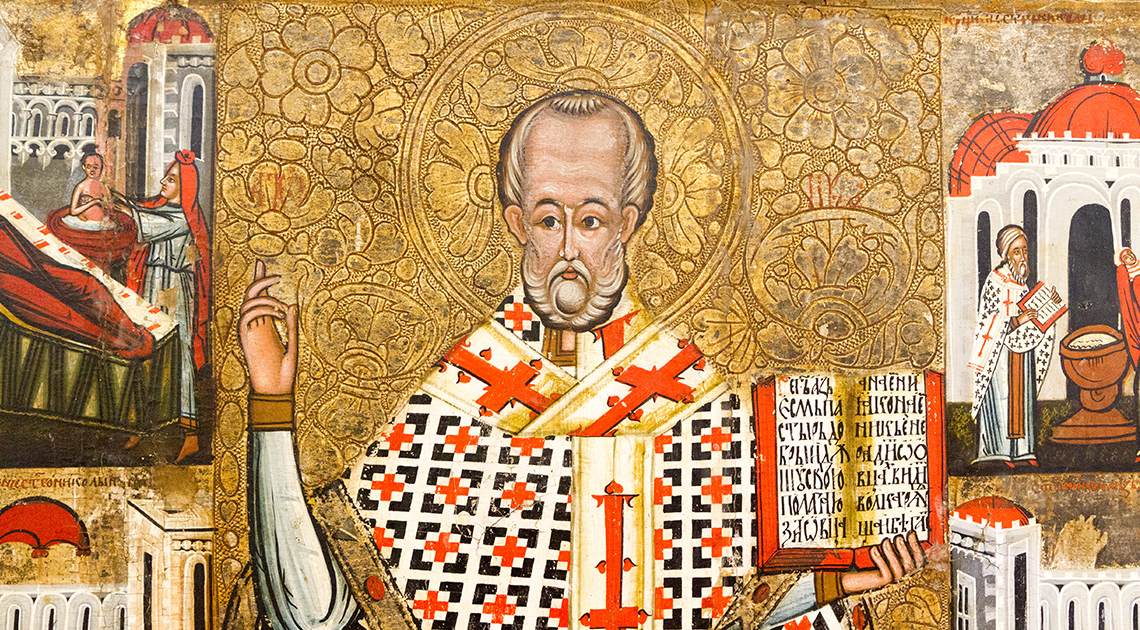While Santa Claus is known by boys and girls across the world today, the magical toy-giving character got his start as a very real Christian bishop in the ancient Roman Empire. Stories of him quelling storms, saving the lives of prostitutes, and even bringing babies back to life have been spread throughout the centuries.
Little about Saint Nicholas was actually recorded by his contemporaries. He came to prominence during perilous times in the Roman Empire and was mostly written about after he had already died. Born in the port town of Patara in Asia Minor—present-day Turkey—Nicholas was the son of wealthy Greek Christians. After his mother and father died, it’s said he donated their wealth to the poor. Legend has it that he gave three bags of gold over three nights to a man who had no money for his daughters’ dowries. According to the story, it was only with the help of Nicholas’s gold were they spared from prostitution.

Nicholas then is said to have traveled to the Holy Land. While traveling aboard a ship, it’s said he rebuked the raging sea, calming the storm and saving his ship.
Upon returning from the Middle East, Nicholas literally wandered into being a bishop. The church in Myra had lost their priest, and decided the next priest to walk through their doors would be named bishop. Reportedly, Nicholas soon wandered in to pray.

Saint Nicholas’s next act of gallantry has many different versions. In many, he interrupts the execution of three men by throwing down the headsman’s sword and freeing the prisoners of their bonds before chastising a juror who had been bribed. In other versions, he spares the lives of three innocent generals by appearing in the dreams of Holy Roman Emperor Constantine.

The firm of Saint Nicholas falls upon Arius’s face.
In 325 AD, Constantine held a meeting for bishops to discuss the nature of the Holy Trinity. A bishop from Egypt, Arius, opposed the idea that Jesus was an equal part of the trinity, an idea Nicholas vehemently disagreed with. While the fellow holy man was sharing his ideas, Nicholas became so upset that he slapped Arius across the face. Accounts vary as to how Nicholas was punished, but some say he was stripped of his rank and thrown in chains, only to be rescued by an apparition of Jesus and the Virgin Mary who restored his station.
In perhaps the most gruesome story involving Saint Nicholas, a butcher lured three children into his home outside the city. There he killed and pickled the children in a barrel, planning to pass them off as ham for sale. Traveling to the area to provide famine relief, Nicholas saw through the ruse and is said to have resurrected the children from the brine.

Thanks to the many illustrious stories of Sint Nicholas’s work, he would come to be known as the patron saint of children, sailors, prostitutes, pawnbrokers, coopers, and the falsely accused. His acts of charity are what inspired the Germanic tradition of Santa Claus. Nicholas was known for wandering the streets at night, leaving little gifts for people in their homes. His bedtime attire during these late-night escapades even makes their way to the nightcap stylings of Santa.
While dead, Nicholas had little time to rest. A cathedral was built in his honor, cementing his Sainthood. Though his bones were interred for a time, they were eventually disturbed, stolen, and spread across Europe as relics. Known widely as Nicholas the Wonderworker, tales of his many miracles made his artifacts highly coveted by different churches. A few pieces of the saint were returned home in later years, but most were lost. To this day, many cities still have an honorary tomb for the 4th-century saint.

Robert Ripley visited Saint Nicholas’s burial site in Bari, Italy, in 1936.










Comment Your Reaction